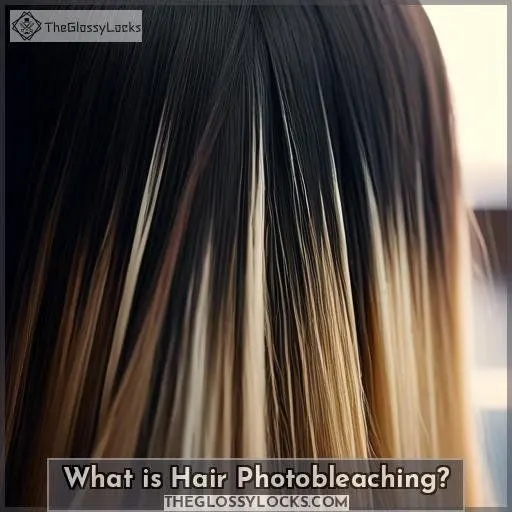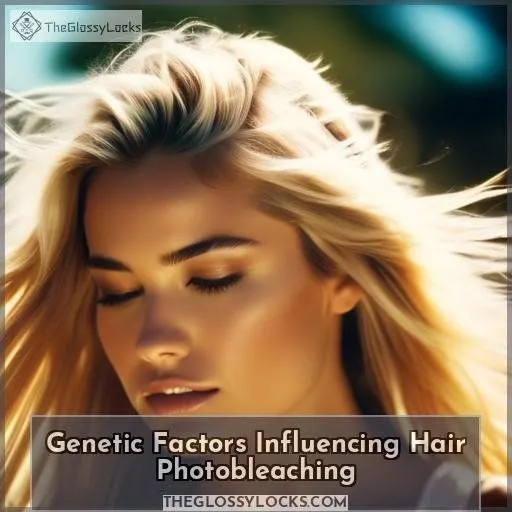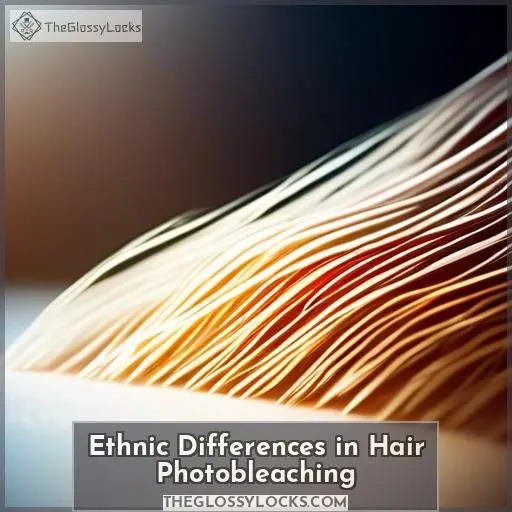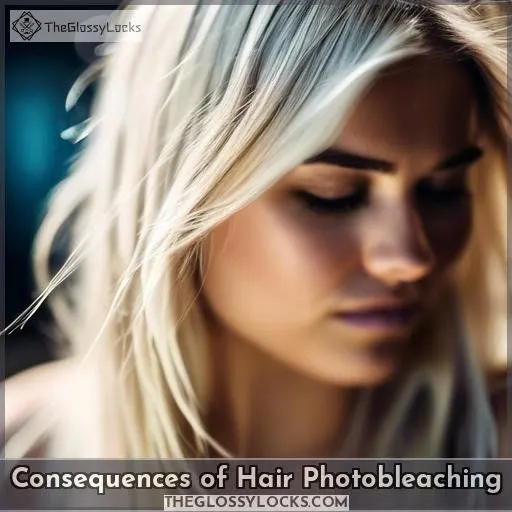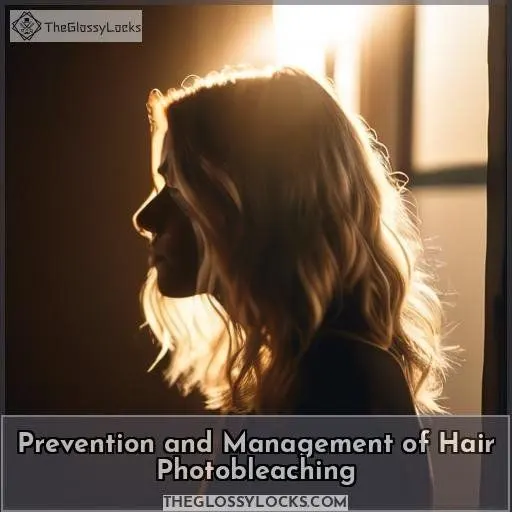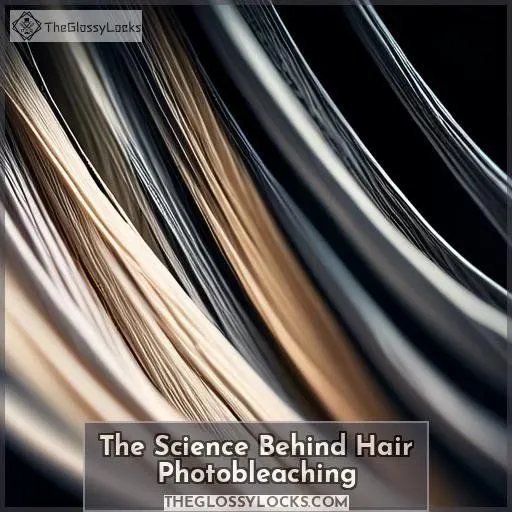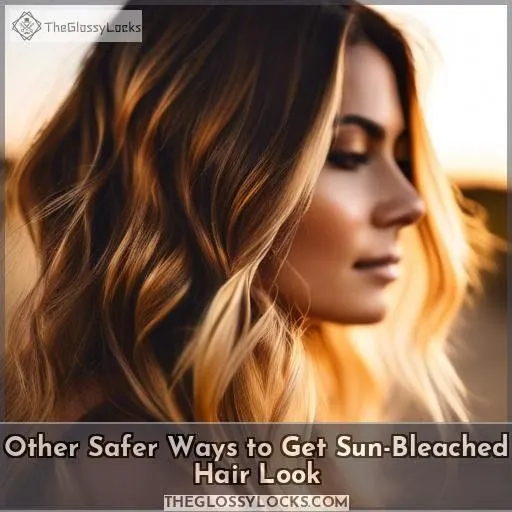This site is supported by our readers. We may earn a commission, at no cost to you, if you purchase through links.
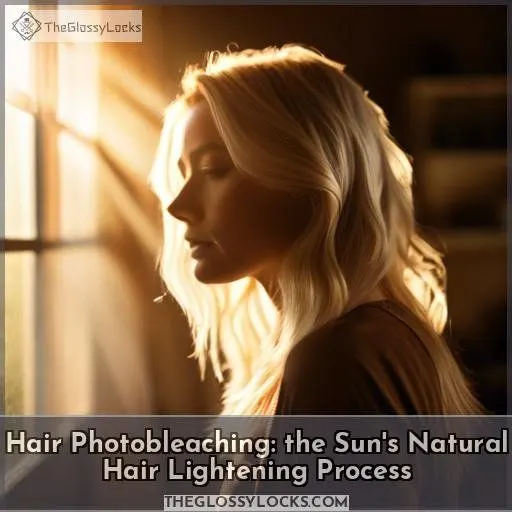
Did you know that the sun’s UV rays can naturally lighten your hair through a process called photobleaching? When the sun’s rays interact with the melanin pigments in your hair, it causes them to break down, resulting in a lightened hair color.
This uneven bleaching effect can lead to damaged, dry, and brittle hair that may not return to its original shade. To prevent sun-related hair woes, limit your exposure during peak hours, use UV-protective hair products, and regularly condition and moisturize your locks.
Curious to learn more about the science behind this natural hair lightening process?
Table Of Contents
- Key Takeaways
- What is Hair Photobleaching?
- Genetic Factors Influencing Hair Photobleaching
- Ethnic Differences in Hair Photobleaching
- Consequences of Hair Photobleaching
- Prevention and Management of Hair Photobleaching
- The Science Behind Hair Photobleaching
- Other Safer Ways to Get Sun-Bleached Hair Look
- Frequently Asked Questions (FAQs)
- Conclusion
Key Takeaways
- Hair photobleaching is a natural process that occurs when the sun’s UV rays interact with the melanin pigments in hair, causing them to break down and lighten the hair color.
- This process can lead to uneven color, damage, and brittleness in hair, which may not return to its original shade.
- To prevent hair photobleaching, limit sun exposure, use UV-protective hair products, and regularly condition and moisturize your hair.
- Genetic markers play a role in hair photobleaching, with 48 specific genetic markers identified by 23andMe that regulate melanin production and determine hair color.
What is Hair Photobleaching?
You may have noticed your hair appearing lighter after a summer of sun exposure. This is because the sun’s UV rays interact with the melanin pigments in your hair, causing a natural bleaching process known as photobleaching. Photobleaching lightens hair by breaking down the melanin molecules, leading to a gradual color change from your roots to the ends.
How Does Sun Bleached Hair Work?
Imagine your hair as a vibrant city, bustling with melanin production.
The citizens giving it color and life.
Enter UV rays, the unruly tourists, disrupting the peace and causing hair photobleaching.
These ultraviolet rays break down the city’s defenses, leading to sun bleached hair.
While genetic markers may predispose some to more damage, protective measures can shield our hair’s metropolis from these unwelcome visitors.
Why Does the Sun Lighten Your Hair?
The sun’s UV rays can lighten hair by breaking down the melanin pigment, causing it to become oxidized and broken into smaller molecules. This process, known as photobleaching, can lead to a lighter appearance in hair, particularly in individuals with lighter hair colors due to the higher levels of pheomelanin, which is more susceptible to UV damage. However, it’s essential to recognize that this lightening effect is distinct from the authentic lightening that occurs when hair is chemically bleached.
To protect your hair from the sun’s damaging effects, consider the following tips:
- Limit Sun Exposure: Spending extended periods in direct sunlight, especially during peak summer months, can lead to more pronounced effects on hair color. Wearing a hat or scarf can help minimize the harmful effects of the sun on your hair.
- Use UV-Protective Hair Products: Look for hair care products that contain UV protection, such as shampoos and conditioners, to help shield your hair from the sun’s rays.
- Regular Hair Conditioning and Moisturizing: Keep your hair hydrated and strong by conditioning regularly and using moisturizing products to prevent damage from the sun.
Does Sun Bleached Hair Go Back to Normal?
Hair photobleaching, a natural process, can lead to hair discoloration and damage.
While hair may not return to its original color, using hair products with UV protection and regular conditioning can help maintain hair health.
Hair growth and color are influenced by hair follicle life cycle and photochemical effects.
Hair types and pigment levels also play a role in hair bleaching.
Genetic Factors Influencing Hair Photobleaching
Did you know that genetic markers play a pivotal role in hair photobleaching? 23andMe has identified 48 specific genetic markers linked to this phenomenon, which regulate melanin production and determine hair color. Exploring this further, the service’s Health + Ancestry reports can provide insights into your hair’s potential for sun-induced lightening, allowing you to better understand its unique response to UV radiation.
Did You Know?
Did you know that sun-lightened hair is often associated with a beachy, sun-kissed look? But did you also know that this natural process can be influenced by genetics and sun exposure? 23andMe has identified 48 genetic markers linked to hair photobleaching, and hundreds of genes influence hair color. People with European ancestry are more likely to experience sun-lightened hair, with 72% of 23andMe customers reporting this trait.
But not everyone is equally affected by the sun’s UV rays. The level of melanin in your hair determines the impact of sun exposure, with people with less melanin (blonde or lighter hair) being more affected. And while some may embrace the sun-bleached look, others may prefer to protect their hair health by limiting sun exposure and using UV-protective hair products.
If you’re looking for a more controlled way to lighten your hair, you might consider natural methods like lemon juice or chamomile tea, which can help enhance hair color without the potential damage of prolonged sun exposure. Remember, hair photobleaching is a natural process, but it’s also important to take care of your hair and maintain its health.
Explore More
If you’re curious about your hair’s response to UV radiation, consider 23andMe’s Trait Reports. These reports can predict your hair’s likelihood of photobleaching based on your genetic predisposition. The amount of melanin in your hair plays a key role in this process. People with less melanin, such as those with blonde or lighter hair, are more vulnerable to photobleaching. Europeans are also more likely to experience hair photobleaching than other racial or ethnic groups.
Genetic testing can provide valuable insights into your hair’s response to UV radiation. It can help you understand your hair’s susceptibility to damage and aging, which may lead to hair loss or excess hair growth. To prevent hair damage, consider using UV-protective hair products and practicing regular hair conditioning and moisturizing. Additionally, you might want to limit your sun exposure to maintain overall hair health and reduce the risk of skin cancer.
Ethnic Differences in Hair Photobleaching
Hair photobleaching is a natural process that affects people of all ethnicities, but it’s more common in individuals with European ancestry. The genetic makeup of hair determines the susceptibility to photobleaching, with people of non-European descent having lower chances of experiencing it. The severity of photobleaching also depends on factors like melanin content and exposure to UV rays.
Consequences of Hair Photobleaching
Prolonged sun exposure leads to uneven hair color, with darker roots and considerably lighter strands. This photobleaching process can also cause hair damage and dryness, leaving your tresses brittle, dry, and prone to breakage.
Uneven Hair Color
Uneven hair color is a common result of hair photobleaching. As hair is exposed to the sun, the melanin pigment in hair is depleted, leading to uneven color distribution, patchy hair, and sun spots. To address this issue, consider the following tips:
- Equal Application: Make sure that the bleach is applied evenly throughout your hair. Use a brush or applicator to focus on specific areas that need further lightening.
- Monitor Processing Time: Pay close attention to the bleaching process and rinse out the bleach as soon as the desired level of lightening is reached.
- Seek Professional Help: For more complex cases, consult a professional hairstylist who can guarantee proper application and minimize the risk of damage.
Hair Damage and Dryness
Sun-bleached hair can lead to significant damage and dryness.
Prolonged sun exposure can cause split ends, premature aging, and scalp damage.
In some cases, hair may even thin or experience hair loss due to scalp sunburn.
It’s absolutely necessary to protect your hair from the sun’s harmful UV rays to prevent these issues.
Regular conditioning and moisturizing can help restore some of the lost moisture and protect your hair from further damage.
Weakened Hair Prone to Breakage
When you bask in the sun’s glory, your hair pays the price. Sun exposure can lead to melanin depletion, turning your once resilient locks into fragile strands. It’s not just about faded color; it’s the strength of your hair on the line. To combat this, consider breakage prevention as your new mantra.
- Limit direct sun exposure
- Invest in UV protection hair products
- Regularly condition to fortify strands
- Avoid harsh chemicals and heat styling
- Embrace hats or scarves for chic defense
Prevention and Management of Hair Photobleaching
To mitigate the damaging effects of hair photobleaching, you should limit your sun exposure, especially during peak hours when UV radiation is most intense. Additionally, investing in UV-protective hair products containing sunscreens, antioxidants, and conditioning agents can help fortify your hair strands, minimizing discoloration, dryness, and breakage caused by prolonged sun exposure.
Limit Sun Exposure
Limiting sun exposure is essential for maintaining hair health and preventing photobleaching.
Protect your hair from UV damage by seeking shade, wearing hats, and using sun protection products.
Embrace a beachy look without sacrificing your hair’s vibrancy.
Keep your hair healthy and strong by being mindful of your sun exposure during the summer months.
Use UV-Protective Hair Products
To protect your hair from the sun’s UV rays, consider using UV-protective hair products. Here are some options:
- UV-protective shampoos: Cleanse your hair while safeguarding it from the sun’s harmful rays.
- UV-protective conditioners: Nourish your hair and shield it from the sun’s damaging effects.
- UV-protective sprays: Quickly apply a protective layer to your hair before heading outdoors.
- UV-protective hair masks: Deep condition your hair and fortify it against UV damage.
- UV-protective hats: Wear a hat to shield your hair from direct sunlight.
Regular Hair Conditioning and Moisturizing
After shielding your locks with UV-protective products, don’t skimp on regular conditioning and moisturizing. This dynamic duo is your hair’s best defense against the ravages of sun exposure. Think of conditioner as a knight in shining armor, safeguarding your strands from the dryness and breakage that come with basking in the sun’s glory.
| Hair Care Ritual | Benefit | Frequency |
|---|---|---|
| Deep Conditioning | Replenishes moisture | Weekly |
| Oil Treatments | Nurtures and strengthens | Bi-weekly |
| Leave-in Conditioner | Shields from daily damage | Daily |
| Hydrating Masks | Revives sun-kissed strands | As needed |
The Science Behind Hair Photobleaching
You’re probably wondering about the science behind hair photobleaching. Melanin, the pigment responsible for hair color, consists of two types: pheomelanin and eumelanin. Pheomelanin is more susceptible to sun-induced oxidation, while eumelanin is more resistant; this difference in photosensitivity between the two melanin types contributes to the varied effects of photobleaching across individuals.
Melanin and Chromophores
Melanin production is a complex process that plays a pivotal role in determining hair color and its vulnerability to photobleaching. The quantity and type of melanin in hair are influenced by various genes, with eumelanin (black or brown) and pheomelanin (red) being the primary pigments. Genetic predisposition, duration of sun exposure, and hair care strategies can all affect melanin production and the probability of hair photobleaching.
To enhance melanin production, focus on a balanced, nutrient-dense diet with antioxidant-rich foods like berries, nuts, beans, citrus fruits, and leafy greens. Consuming foods high in copper, such as crab meat, almonds, lentils, peanuts, and beef liver, may also support melanin production in hair. Additionally, managing stress and following sun protection protocols can help maintain melanin levels in your hair.
Although it’s difficult to undo hair photobleaching once it has occurred, addressing any underlying factors affecting melanin production could help prevent further color loss. For instance, minimizing sun exposure, utilizing UV-protective hair products, and practicing regular hair conditioning and moisturizing can help maintain hair health and reduce the risk of photobleaching.
Pheomelanin Vs. Eumelanin
As we explore deeper into the science behind hair photobleaching, let’s investigate the role of pheomelanin and eumelanin, the two types of melanin present in hair.
Pheomelanin is responsible for red, yellow, and orange hues, while eumelanin is responsible for black, brown, and dark brown hues.
When exposed to sunlight, pheomelanin is more susceptible to photobleaching, which is why people with lighter hair, containing more pheomelanin, are more likely to experience hair lightening.
On the other hand, eumelanin is less affected by sunlight, making hair with more eumelanin less likely to lighten.
Understanding these differences can help us better comprehend the complex interplay of genes and environmental factors influencing hair photobleaching.
Other Safer Ways to Get Sun-Bleached Hair Look
Don’t want to risk the damaging effects of sun exposure? You can achieve a similar sun-kissed, beachy look through safer alternatives like using lemon juice or getting highlights and balayage. These hair treatments can lighten your locks without subjecting them to the sun’s harsh UV rays.
Using Lemon Juice
Lemon Juice: A Natural Hair Lightener
Lemon juice is a widely used natural hair lightener, providing a safe and budget-friendly option to chemical hair dyes and bleach. Here are some crucial factors to keep in mind when utilizing lemon juice for hair lightening:
- Lemon juice efficacy: Lemon juice can lighten hair, particularly in lighter hair shades like blonde and light brown. However, it may not be as effective on darker hair colors.
- Lemon juice safety: While lemon juice is typically safe to apply to hair, it can be acidic and may cause dryness, frizzy locks, and hair breakage if not handled properly. It’s vital to mix lemon juice with water and rinse it out thoroughly after use.
- Lemon juice alternatives: Other natural hair lighteners include chamomile tea, which is most effective on light brown or blonde hair.
- DIY hair lightening: To lighten hair with lemon juice, combine it with water and apply it to your hair. Expose your hair to sunlight to speed up the bleaching process, but be sure to protect your skin with sunscreen.
- Precautions: Lemon juice can irritate the skin and cause contact reactions, so it’s advisable to perform a patch test before applying it to your hair and scalp.
Highlights and Balayage
If you’re looking for a sun-kissed, beachy look without the harmful effects of UV rays, consider highlights and balayage. These hair styling techniques can give your hair a sun-bleached appearance without the need for prolonged sun exposure.
Highlights involve applying a lighter color to specific sections of your hair, while balayage is a more natural-looking technique that involves painting highlights onto your hair to create a soft, graduated effect. Both methods can help you achieve the desired sun-bleached look without the risk of photobleaching.
Frequently Asked Questions (FAQs)
How does hair photobleaching affect hair texture?
Hair photobleaching can leave your locks like a sun-kissed warrior, battle-worn yet stronger than ever. The UV onslaught may ruffle your strands, but you emerge resilient, ready to conquer the day.
What are the long-term effects of hair photobleaching?
Prolonged sun exposure can wreak havoc on your locks, leaving them dry, brittle, and prone to breakage. But don’t despair – with the right hair care routine, you can keep your tresses looking fabulous, even in the scorching sun.
Can hair photobleaching be reversed?
Oh, you bet your sun-kissed locks can bounce back from photobleaching! Just slather on some deep conditioning treatments, lay off the UV rays, and watch your hair reclaim its natural glory. It’s a breeze, my friend!
How does hair photobleaching affect hair growth?
Hair photobleaching can weaken and dry out your hair, slowing down growth. But don’t fret – a nourishing hair care routine and limiting sun exposure can get your locks back on track in no time. You’ve got this!
Is hair photobleaching more common in certain hair types?
You bet – hair photobleaching is more common in hair types with lower melanin content, like blondes and those with European ancestry. Their lighter strands are simply more susceptible to sun-driven color shifts. Embrace your sun-kissed glow!
Conclusion
Undeniably, the sun’s rays have a remarkable ability to naturally lighten your hair through the process of hair photobleaching. While this sun-kissed look may initially captivate, it’s essential to comprehend the potential consequences – uneven color, damage, and brittleness.
To preserve the health and vibrancy of your tresses, take proactive steps like restricting sun exposure, utilizing UV-protective products, and maintaining a robust conditioning routine. Remember, with proper care, you can enjoy the sun-bleached allure without jeopardizing the integrity of your hair.

